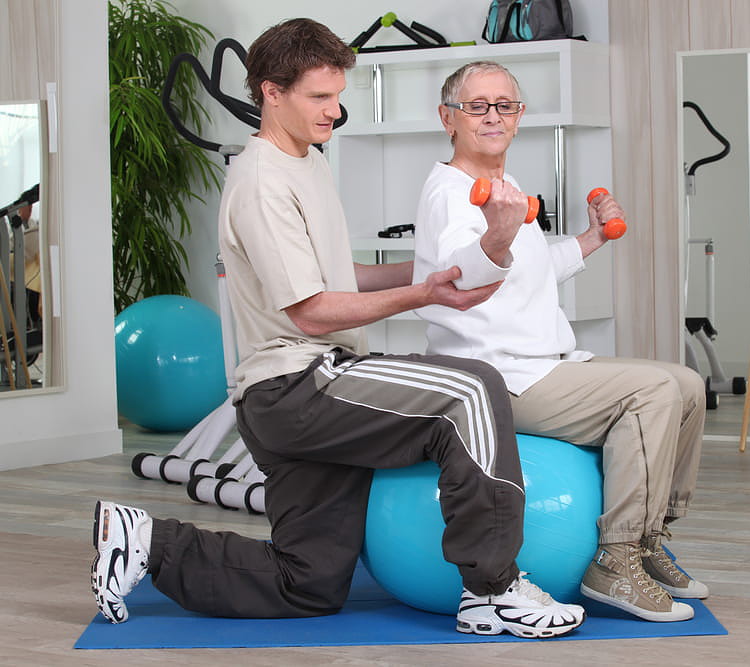If you work at home and you’re tired of sitting in your office chair all day, then maybe it’s time you alternate your time between your office chair, standing, and bouncing on an exercise ball. It may come as a surprise to you what an exercise ball can do for you.
Yes! Bouncing on an exercise ball does burn calories. Continuous bouncing on a stability ball for one hour can burn 50 calories. That doesn’t seem like a lot, but that begs the question, can you lose weight bouncing on an exercise ball? No need to ponder; we have the answer to your questions here.
Table of Contents
Does Bouncing on an Exercise Ball Burn Calories?

Yes, bouncing on an exercise ball burns calories. Anytime you move your body, whether that’s sitting down, standing up, squatting, kneeling, walking, you’re burning calories. It helps if you are engaging your muscles as well since that will burn more calories.
Believe it or not, even if you are just sitting on an exercise ball, you are burning calories. When you sit on an unbalanced surface, it requires you to engage the smallest muscles in your core, abs, and lower back to keep you upright and prevent you from falling over.
You won’t burn as many calories as you would if you are bouncing. But we’ll take anything we can get!
Is it good to bounce on an exercise ball?
It is good to bounce on an exercise ball if you do it the right way and the right amount of time. A few questions down we will answer how long you should bounce for.

Here are the steps for finding the proper sitting form on an exercise ball:
Step 1 – Find a neutral lumbar spine position. To do this, you’ll sit tall on the exercise ball with a slight slouch forward, rounding your lower and upper back. Your legs will be in front of you, bent at a 90-degree angle.
Step 2 – Engage your core and start bouncing lightly, using your legs to push yourself up and down on the exercise ball. Keep your feet flat on the floor the entire time to stabilize yourself and prevent yourself from falling over.
If your balance isn’t the best, then sit your stability ball next to a wall or desk and use your hand for even more stability. For people with shorter legs or better balance, feel free to lift your legs off the ground; just be careful!
Focus on bouncing up, not down. Let your body move to its neutral and natural position as you bounce up and down on the ball.
Step 3 – Take a break when you need it. As your body gets tired, it’s only natural for it to lose good posture.
Bouncing on your yoga ball with bad posture won’t do your back any favors. So, take a break from the yoga ball, sit in a chair for several minutes and come back when you’re ready.
How Many Calories are Burned Bouncing on an Exercise Ball?

According to a personal trainer, Monica Vazquez from New York Sports Clubs, you can burn 50 calories in an hour by bouncing on an exercise ball continuously.
To burn 50 calories, your bounces need to be consistent and not a bounce or two here and there. You also need to take into consideration how fast you are bouncing. A fast bounce will burn a lot more calories than a slow bounce.
How Long Should you Bounce on an Exercise Ball?
The answer to how long you should bounce on an exercise ball depends on multiple factors:
- Current fitness level
- Health problems
- Productivity
- Pregnancy
In general, you can bounce on an exercise ball for 30 to 60 minutes per day. With that said, you should also consider a few other factors that we discuss in more detail below.
Current fitness level

If you exercise daily and your core is as strong as Dwayne Johnson’s or Jillian Michael’s on weight watchers, then you can probably handle a few hours bouncing on an exercise ball. Though for the average person, the time spent bouncing on an exercise ball should be a lot less.
The average fit person should limit their bouncing on an exercise ball to 60 minutes or less. The most important thing to pay attention to is how your body responds to the bouncing.
If your body fatigues at thirty minutes, that’s your max amount of time on a stability ball. Don’t feel bad if it’s ten minutes. Listen to what your current fitness level tells you, and don’t push it.
Health problems
People with spinal injuries, back surgeries, and other core-related health problems should always ask their doctors first if they can bounce on an exercise ball in the first place. You don’t want to place more pressure or pain if you don’t need to.
If you can, your doctor will provide you with the length of time you should spend bouncing on an exercise ball. Listen to your doc and don’t hurt yourself further.
Productivity

This one we find interesting. Many people are swapping out their work chairs with supposedly ergonomic exercise ball chairs or just the balls themselves.
A recent study found that sitting and bouncing on an exercise ball all day at work leads to more discomfort and possibly worse posture that leads to more back and neck pain.
Is it okay for office workers to have an exercise ball and bounce intermittently on it? Sure. The length you spend bouncing on the yoga ball will depend on your body’s comfort level.
But bouncing on an exercise ball all day is not healthy for you. Sitting on an exercise ball all day at work is also not good for your body.
If you notice your productivity at work tasks decline when you bounce on an exercise ball, then maybe you should take the exercise ball out of the picture. On the other hand, if bouncing on an exercise ball doesn’t negatively affect your concentration or work performance, go ahead and bounce.
Pregnancy

A lot of pregnant women use yoga balls to help move a baby’s head into the birthing canal. The Bump website recommends bouncing on an exercise ball for a few minutes throughout the day.
Always listen to your OB-GYN as every woman’s body is different and their time bouncing on a yoga ball will fluctuate based on underlying health problems while pregnant.
Can you Lose Weight Bouncing on an Exercise Ball?
Bouncing on an exercise ball has the potential to create a calorie deficit that can help you lose weight. With that said, you can’t rely on a stability ball as your only tool for weight loss, mainly if all you’re using it for is sitting or bouncing.
Now, if you add in multiple exercises for a full-blown workout along with bouncing, that’s a different story. Simply bouncing on an exercise ball won’t give you the massive weight loss results you’re looking for, though it’s a great start for toning your abs and lower back and building a stronger core.
How do you lose belly fat on an exercise ball?
The best way to lose belly fat on an exercise ball is through a full exercise plan. You can start your workout bouncing on a stability ball for five minutes then move into the deeper, sweat-provoking moves.
Follow a 30-minute routine four to five times per week for the best belly fat loss journey. You’ll want to target the deepest parts of your abdominal muscles to lose that stubborn belly fat.
Watch this eight-and-a-half minute-long YouTube video with the 15 best stability exercises to lose belly fat. In case you don’t have time now to watch the video, we’ve listed below the 15 exercise ball moves included in this video.
- Elbow Planks (elbows on the ball)
- Elbow Planks (feet on the ball)
- Straight-arm Planks (hands on the ball)
- Straight-arm Planks (feet on the ball)
- Plank with Knee Tuck
- Plank with Pike Tuck
- Buzzsaw Plank
- Alphabet Plank
- Side to Side Plank
- Dead Bug
- Lower Back Extension
- Kneeling Roll-outs
- T-spine Twists
- Windshield Wipers (ball between your feet)
- Leg Lift (ball between your feet)
Summary
All in all, bouncing on an exercise does burn calories, but the amount of calories you burn is not enough to achieve your major weight loss goals. The length of bounce time varies depending on your health situation and fitness levels.
Once you understand that bouncing on a stability ball can burn 50 calories an hour through consistent bouncing, you now have a 30-minute exercise ball workout to burn more calories and lose weight.

My name is Vance, and I am the owner of To Ergonomics. Our mission is to improve your workflow by helping you create a supportive and welcoming environment. We hope that you’ll find what you’re looking for while you’re here.

